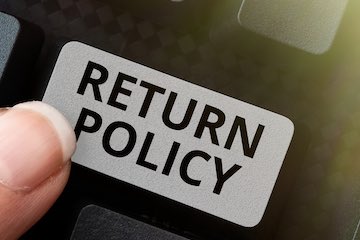
For the 2021 holiday season, which started with promotions in October, many retailers implemented more lenient policies — extending the number of days for returns from 30 to 60 or 90 days. Amazon extended its return policy for holiday gifts until January 31, while Walmart will accept returns until March 26, 2022, for products bought from November 1 through December 25.
For all merchants — online and brick-and-mortar — auto parts had the highest return rates, with an average of 19.4%, according to the survey. Next is apparel, with an average return rate of 12.2%, followed by home improvement and housewares that both came in at an average of 11.5%.
According to Narvar, factors contributing to increased return expense are:
However, after two years of Covid, the financial pain is causing many smaller sellers to re-evaluate return policies. Some have pulled back on free returns as reverse logistics costs soared.
- Sixty-three percent of D2C brands have a 30-days-or-less return policy.
- Thirty-nine percent of all retailers offer a 30-day return policy.
- Forty-five percent of omnichannel retailers and 22% of D2C sellers cover return shipping costs.
According to the NRF, for every 0 in returned merchandise accepted, retailers lose .30 to return fraud, such as buying an item with no intention of keeping it, returning goods with no receipt from another retailer, or returning stolen merchandise.
- Higher shipping costs during the holidays.
- Increased warehouse costs.
- Bracketing — when customers order two similar products with the expectation of returning one of them. In 2021, 58% of customers surveyed by Narvar said they had bracketed at least once in the prior six months, up from around 40% before the pandemic.
Returnless Refunds
On average, retailers expect to receive about 16.6% of total merchandise customers purchased in 2021, according to survey results extrapolated from 57 U.S. retailers conducted in October and November of last year by the National Retail Federation and software provider Appriss Retail. That’s a jump from an average return rate of 10.6% in 2020 and amounts to more than 1 billion. NRF reports that the average rate of returns for online purchases was 20.8%, an increase from 18.1% last year.
2021 Holiday Returns
As of October 2021, Amazon requires Fulfillment by Merchant sellers of fashion products to offer free returns at their own expense. But Fulfilment by Amazon sellers incur only small fees, not the entire shipping cost. Amazon may be trying to push FBM sellers into its FBA program. Other product categories may eventually come under this requirement.
Optoro, which works with retailers and manufacturers to manage and resell returned merchandise, said it expects U.S. shoppers to return 0 billion in goods between Thanksgiving 2021 and January 31, 2022.
B-Stock, an online auction site for returned and liquidated goods, says that between billion and billion of U.S. 2021 holiday returned goods were online purchases. B-Stock expects overall holiday returns to increase about 10% over last year, reaching as high as 4 billion, somewhat less than Optoro’s estimate.
How to handle product returns has bedeviled merchants for years. Balancing costs with customer satisfaction and loyalty is a struggle. The pandemic has worsened the problem — especially for ecommerce sellers — as product returns to U.S. merchants skyrocketed in 2021, beyond the already higher volumes in 2020.
UPS calculates that it delivered a record-breaking 60 million packages back to American merchants between November 14, 2021, and January 22, 2022, about 10% more than 2020.
Customer experience platform Narvar has over 800 retail clients worldwide and, according to the company, the percentage of its clients that allow free returns is about 50%, a decrease from a few years ago. Last year Narvar conducted a survey of return policies with 197 omnichannel and direct-to-consumer online merchants. The results were published in August 2021:
Amazon FBM Returns
Many large merchants such as Amazon, Target, and Walmart often let customers keep low-price items they want to return if the transit cost eliminates any profit. Those companies use algorithms to determine qualifying goods. However, the process can increase fraud as some customers count on keeping products they say they wish to return. Consulting firm AlixPartners estimates that U.S. returnless refunds reached .4 billion in 2021.






